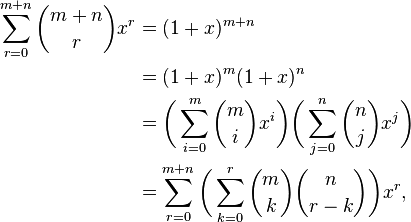Vandermonde's identity
In combinatorics, Vandermonde's identity, or Vandermonde's convolution, named after Alexandre-Théophile Vandermonde (1772), states that
for binomial coefficients. This identity was given already in 1303 by the Chinese mathematician Zhu Shijie (Chu Shi-Chieh). See Askey 1975, pp. 59–60 for the history.
There is a q-analog to this theorem called the q-Vandermonde identity.
Algebraic proof
In general, the product of two polynomials with degrees m and n, respectively, is given by
where we use the convention that ai = 0 for all integers i > m and bj = 0 for all integers j > n. By the binomial theorem,
Using the binomial theorem also for the exponents m and n, and then the above formula for the product of polynomials, we obtain
where the above convention for the coefficients of the polynomials agrees with the definition of the binomial coefficients, because both give zero for all i > m and j > n, respectively.
By comparing coefficients of xr, Vandermonde's identity follows for all integers r with 0 ≤ r ≤ m + n. For larger integers r, both sides of Vandermonde's identity are zero due to the definition of binomial coefficients.
Combinatorial proof
Vandermonde's identity also admits a combinatorial double counting proof, as follows. Suppose a committee consists of m men and n women. In how many ways can a subcommittee of r members be formed? The answer is
The answer is also the sum over all possible values of k, of the number of subcommittees consisting of k men and r − k women:
Geometrical proof
Take a rectangular grid of r x (m+n-r) squares. There are
paths that start on the bottom left vertex and, moving only upwards or rightwards, end at the top right vertex (this is because r right moves and m+n-r up moves must be made (or vice versa) in any order, and the total path length is m+n). Call the bottom left vertex (0,0).
There are  paths starting at (0,0) that end at (k,m-k), as k right moves and m-k upward moves must be made (and the path length is m). Similarly, there are
paths starting at (0,0) that end at (k,m-k), as k right moves and m-k upward moves must be made (and the path length is m). Similarly, there are  paths starting at (k,m-k) that end at (r,m+n-r), as a total of r-k right moves and (m+n-r)-(m-k) upward moves must be made and the path length must be r-k + (m+n-r)-(m-k) = n. Thus there are
paths starting at (k,m-k) that end at (r,m+n-r), as a total of r-k right moves and (m+n-r)-(m-k) upward moves must be made and the path length must be r-k + (m+n-r)-(m-k) = n. Thus there are
paths that start at (0,0), end at (r,m+n-r), and go through (k,m-k). This is a subset of all paths that start at (0,0) and end at (r,m+n-r), so sum from k=0 to k=r (as the point (k,m-k) is confined to be within the square) to obtain the total number of paths that start at (0,0) and end at (r,m+n-r).
Generalized Vandermonde's identity
If in the algebraic derivation above more than two polynomials are used, it results in the generalized Vandermonde's identity. For y + 1 polynomials:
The hypergeometric probability distribution
When both sides have been divided by the expression on the left, so that the sum is 1, then the terms of the sum may be interpreted as probabilities. The resulting probability distribution is the hypergeometric distribution. That is the probability distribution of the number of red marbles in r draws without replacement from an urn containing n red and m blue marbles.
Chu–Vandermonde identity
The identity generalizes to non-integer arguments. In this case, it is known as the Chu–Vandermonde identity (see Askey 1975, pp. 59–60) and takes the form
for general complex-valued s and t and any non-negative integer n. This identity may be re-written in terms of the falling Pochhammer symbols as
in which form it is clearly recognizable as an umbral variant of the binomial theorem. (For more on umbral variants of the binomial theorem, see binomial type) The Chu–Vandermonde identity can also be seen to be a special case of Gauss's hypergeometric theorem, which states that
where  is the hypergeometric function and
is the hypergeometric function and  is the gamma function. One regains the Chu–Vandermonde identity by taking a = −n and applying the identity
is the gamma function. One regains the Chu–Vandermonde identity by taking a = −n and applying the identity
liberally.
The Rothe–Hagen identity is a further generalization of this identity.
References
- Askey, Richard (1975), Orthogonal polynomials and special functions, Regional Conference Series in Applied Mathematics 21, Philadelphia, PA: SIAM, pp. viii+110












